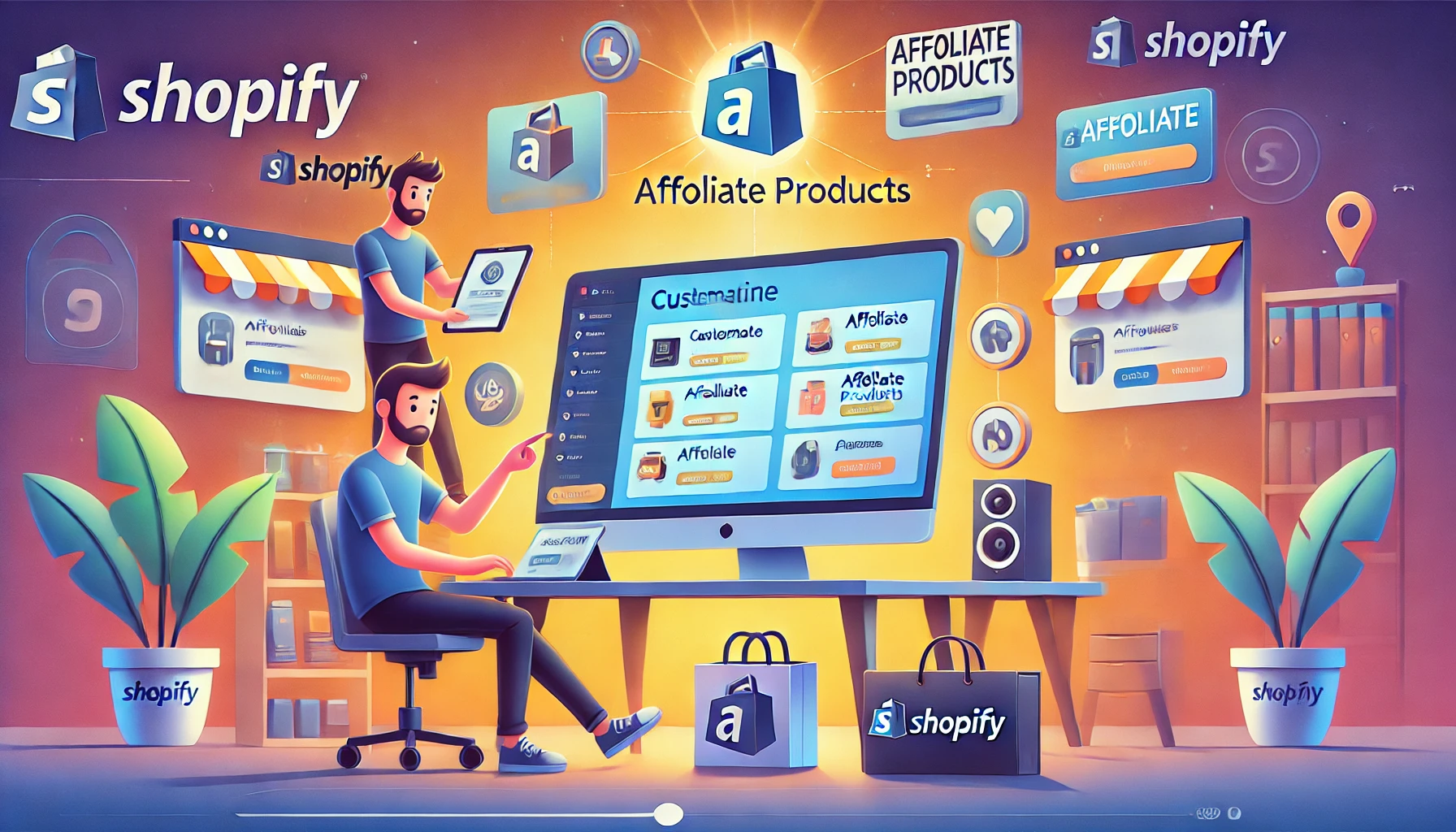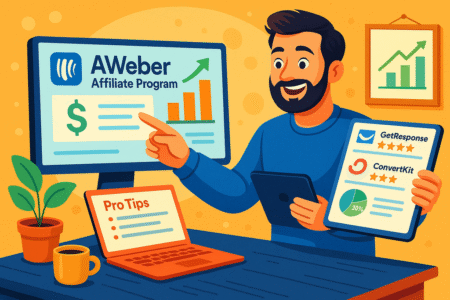Table of Contents
Are you curious about how to sell affiliate products on Shopify effectively? Wondering about the best strategies, tools, and methods to set up your store and drive sales?
This comprehensive guide will provide answers to all these questions and help you master the art of affiliate marketing on Shopify.
Understanding Shopify’s Role In Affiliate Marketing
Shopify plays a pivotal role in helping individuals and businesses sell affiliate products effectively. Its user-friendly platform and robust tools make it an excellent choice for anyone aiming to combine affiliate marketing with an online store setup.
What Is Shopify And Why Use It For Affiliates?
Shopify is a leading e-commerce platform designed to help users create, customize, and manage online stores with ease. For affiliate marketers, Shopify offers unmatched convenience by enabling seamless product listings and link integration, creating a professional store appearance.
Shopify stands out because of its accessibility for beginners and experienced marketers alike. I believe anyone can master its interface without extensive technical knowledge. From hosting to templates, Shopify takes care of the heavy lifting, allowing you to focus on selling affiliate products.
Its versatility ensures that affiliates can tailor their store to align with specific niches or branding strategies. Whether you’re selling tech gadgets, fitness gear, or digital subscriptions, Shopify offers flexibility to match your needs.
I suggest using Shopify if you’re looking for a scalable platform. With options for small businesses and large enterprises, it grows alongside your affiliate marketing efforts. This adaptability ensures long-term success in your endeavors.
If you aim to simplify your workflow, Shopify integrates with countless tools for automation, analytics, and marketing. These features can save you hours while optimizing your store’s performance for better affiliate sales results.
Key Features Of Shopify For Selling Affiliate Products
Shopify boasts numerous features designed to enhance your affiliate marketing efforts. These tools make setting up and managing an affiliate store more efficient and enjoyable, regardless of your technical expertise.
Its customizable templates are a game-changer for affiliate marketers. You can design a store that resonates with your audience without needing coding skills. I recommend exploring the theme store to find layouts that match your niche and branding.
The platform’s app marketplace is another treasure trove for affiliates. Apps like Outlink and Spently can help you manage affiliate links, create compelling emails, and optimize customer experiences. These tools simplify daily operations and increase revenue potential.
Shopify’s integrated SEO tools make it easier to attract organic traffic. With keyword optimization options for product pages, meta descriptions, and images, you can rank higher in search results. A better ranking means more clicks on affiliate links.
Payment gateways are also hassle-free with Shopify. Though you’re promoting affiliate products, Shopify allows for smooth checkout processes for other items, giving you opportunities to diversify income streams while keeping user experience seamless.
Security and reliability are vital for any online store. Shopify ensures your site remains operational and safe with built-in SSL certifications and 24/7 monitoring. I believe this peace of mind is invaluable when managing affiliate sales.
Benefits Of Shopify Over Other Platforms For Affiliates
Shopify’s distinct advantages make it the top choice for affiliate marketers. It combines functionality, scalability, and ease of use, setting it apart from other e-commerce platforms.
One major advantage is its all-in-one approach. I advise marketers to consider Shopify if they want to avoid juggling multiple tools for hosting, design, and marketing. This streamlined experience saves time and reduces stress.
Its scalable plans are another standout feature. As your affiliate store grows, Shopify lets you upgrade without disrupting your operations. Whether you’re starting small or expanding globally, Shopify grows with your needs.
I suggest paying attention to Shopify’s robust support system. With 24/7 customer support, forums, and resources, you’ll always have help at your fingertips. This access can be a lifeline when challenges arise in your affiliate journey.
Another benefit is Shopify’s ability to integrate with affiliate-friendly apps and plugins. Unlike competitors, Shopify’s ecosystem allows seamless connections, making it easier to manage affiliate links and optimize store performance.
Shopify’s reputation for reliability should also not be overlooked. With a history of supporting millions of online businesses, it’s a trusted name that ensures your store operates smoothly, enhancing trust with your customers.
Setting Up A Shopify Store For Affiliate Products

Setting up a Shopify store for affiliate products is a straightforward process with the right guidance. From choosing the perfect plan to optimizing your layout, Shopify makes it easy to build a professional and effective affiliate store.
How To Choose The Right Shopify Plan For Affiliates
Selecting the ideal Shopify plan is the first step in your affiliate marketing journey. Each plan offers features tailored to different needs, ensuring that affiliates can find the best fit for their business model and goals.
I suggest starting with the Basic Shopify plan if you’re new to affiliate marketing. It provides essential tools for setting up your store and experimenting with your niche without a high upfront cost.
For established affiliates, the Shopify and Advanced Shopify plans are excellent choices. These options offer enhanced analytics, advanced reporting, and lower transaction fees, making them ideal for scaling your store efficiently.
If you’re running a large-scale operation, Shopify Plus provides enterprise-level features. While it comes at a premium price, I recommend it for seasoned marketers aiming to maximize performance and streamline operations.
Remember to evaluate your needs carefully before committing. I believe taking advantage of Shopify’s free trial can help you test the platform and decide which plan aligns with your affiliate marketing goals.
Configuring Your Shopify Store For Affiliate Sales
Once you’ve chosen a plan, the next step is to configure your store for affiliate marketing success. This setup process ensures that your store is optimized to attract, engage, and convert visitors effectively.
Begin by setting up your domain and store name. I suggest choosing a name that reflects your niche and resonates with your audience, as this creates a strong first impression and builds trust.
Customize your store theme to showcase affiliate products effectively. I recommend using clear navigation, high-quality images, and user-friendly layouts to enhance customer experience and guide them to click on affiliate links.
Next, configure essential pages such as About Us, Contact, and Privacy Policy. These pages establish credibility and compliance while providing visitors with necessary information about your affiliate store.
Integrate relevant apps for tracking and managing affiliate links. I believe tools like Outlink make it easier to track performance and enhance click-through rates, ensuring that your store runs smoothly.
Adding Affiliate Links To Your Shopify Store
Adding affiliate links is a critical step in monetizing your Shopify store. This process involves embedding trackable links within product descriptions and other strategic locations to drive sales and earn commissions.
Identify products that align with your niche and audience’s preferences. I recommend focusing on high-quality, in-demand items to increase click-through rates and conversions. The right product selection can make a significant difference.
Use descriptive and engaging text to present affiliate links. I suggest explaining the benefits of each product while incorporating your unique perspective. This approach builds trust and encourages customers to click the links.
Place affiliate links strategically across your store. For example, highlight them in product descriptions, banners, or blog posts. I believe diversification of placement ensures higher visibility and engagement.
Test your affiliate links regularly to ensure they work correctly. Broken links can harm user experience and reduce your earnings. I recommend setting a schedule to verify functionality and update outdated links as needed.
Tips For Customizing Your Store To Enhance Conversions
Customizing your Shopify store can significantly boost conversions and improve the performance of your affiliate marketing efforts. A well-designed store keeps visitors engaged and encourages them to click on affiliate links.
I advise focusing on mobile optimization, as many shoppers browse on their phones. A responsive design ensures your store looks great and functions smoothly on all devices, improving user experience and increasing clicks.
Create compelling calls-to-action (CTAs) to guide visitors. Phrases like “Discover This Must-Have Product” or “Shop Now and Save” can inspire clicks. I suggest testing different CTAs to see which resonate best with your audience.
Highlight customer reviews and testimonials wherever possible. I believe social proof builds trust and credibility, which are crucial for affiliate sales. Showcase positive feedback to reinforce the value of the products you’re promoting.
Utilize analytics to refine your customization efforts. Tracking tools can reveal which elements of your store are driving results and where improvements are needed. This data-driven approach ensures your store evolves with your audience’s needs.
Finding The Best Affiliate Products To Sell
Choosing the right affiliate products can significantly impact your Shopify store’s success. Selecting items that resonate with your audience while offering attractive commissions ensures you maximize revenue while building trust and credibility with your customers.
Top Niches For Affiliate Products On Shopify
Affiliate marketing thrives when you target profitable niches that match your expertise and audience interests. Focusing on popular and evergreen niches ensures a consistent demand for the products you promote.
Health and wellness products are incredibly popular. From supplements to fitness gear, I recommend this niche for its strong customer base and high potential for repeat purchases. People prioritize health, making this category a reliable choice for affiliate marketers.
Technology and gadgets are another lucrative area. Smartphones, accessories, and smart home devices have broad appeal. I believe they perform well due to consistent innovation, driving customers to seek the latest products, which you can promote effectively.
The fashion and beauty niche attracts a diverse audience. Clothing, skincare, and makeup products resonate with shoppers seeking quality and style. I advise researching trends within this category to identify top-performing affiliate products.
Eco-friendly and sustainable products cater to environmentally-conscious consumers. Promoting items like reusable goods or solar-powered gadgets shows your commitment to sustainability while addressing a growing market demand.
Researching High-Commission Affiliate Programs
High-commission programs allow you to earn more per sale, making it easier to achieve profitability. Identifying these programs involves evaluating commission rates, product relevance, and the support they offer to affiliates.
Start by researching affiliate networks like ShareASale, ClickBank, and CJ Affiliate. I suggest these platforms for their extensive catalogs and transparency regarding commissions and terms, making them beginner-friendly and reliable sources for products.
Look for programs offering recurring commissions. For instance, promoting subscription-based services can yield ongoing income for each renewal. I recommend prioritizing these opportunities to establish a steady revenue stream.
Check the credibility of affiliate programs before committing. Trustworthy programs with transparent policies protect your reputation. I believe that partnering with reputable brands enhances customer trust and increases the likelihood of conversions.
Analyze the provided marketing materials. Programs offering banners, email templates, and training resources can simplify your efforts. I suggest leveraging these tools to create polished campaigns that resonate with your audience.
Evaluating Product Demand And Profitability
Assessing demand and profitability ensures the products you promote will sell consistently and provide worthwhile earnings. This analysis helps you avoid wasting time on items with low market interest or inadequate returns.
Use keyword research tools to gauge interest. Search volume for product-related terms reveals how often customers look for them. I recommend targeting products with moderate to high search volume to maximize potential traffic to your store.
Analyze competitor success. Look at similar Shopify stores or affiliate websites to see which products perform well. I believe studying competitors can provide valuable insights into trends and gaps in the market.
Review commission structures carefully. High-ticket items may offer bigger payouts, but low-cost products with frequent sales can be equally lucrative. I suggest balancing your portfolio to cater to both types of opportunities.
Monitor seasonal trends and patterns. Products tied to holidays or specific events may have short bursts of profitability. I advise planning your promotions to coincide with these cycles for maximum impact.
Tools To Help You Find Affiliate Products Quickly
The right tools streamline the process of finding affiliate products by automating research and providing valuable insights. Using these resources saves time and ensures you focus on high-potential items.
Buzzsumo is an excellent starting point. I recommend using it to identify rising topics and products. Understanding what’s trending helps you position your store to meet current customer demands effectively.
Affiliate product marketplaces like Amazon Associates simplify product discovery. They feature extensive catalogs and detailed performance metrics, making them ideal for both new and experienced marketers seeking affiliate opportunities.
SEO tools like SEMrush or Ahrefs are invaluable for niche analysis. I suggest leveraging them to uncover profitable keywords and monitor competitors’ performance, helping you refine your product selection.
Social media platforms like Pinterest and TikTok often reveal emerging trends. Observing user engagement and viral content can inspire product ideas. I believe these platforms provide a pulse on what’s capturing consumer interest in real-time.
Optimizing Product Pages For Affiliate Marketing

Well-optimized product pages are crucial for turning visitors into affiliate sales. They provide essential information, encourage clicks, and improve search rankings, ensuring your Shopify store reaches and converts the right audience.
Crafting Compelling Product Descriptions For Affiliates
Engaging product descriptions entice readers to click on affiliate links. They highlight product features while connecting emotionally with potential buyers, making them feel confident in their purchasing decision.
Start with a strong hook that grabs attention. I suggest using relatable scenarios or bold claims that spark curiosity. For instance, “Transform Your Skincare Routine with This Game-Changer!” invites readers to explore further.
Focus on the benefits instead of features. Explain how the product solves problems or improves lives. I believe this approach resonates more with readers, helping them envision how the item fits into their lifestyle.
Incorporate storytelling elements into descriptions. For example, share a brief anecdote about how the product has helped others. This technique creates a personal connection, encouraging trust and clicks on your affiliate links.
End with a clear call-to-action (CTA). Phrases like “Get Yours Today!” or “Click to Discover More” guide readers to take the next step. I recommend making your CTA persuasive and aligned with the product’s value.
Using SEO Best Practices To Rank Affiliate Pages
SEO drives organic traffic, making it a cornerstone of affiliate marketing. Implementing best practices ensures your product pages rank higher, attract visitors, and generate clicks on affiliate links.
Use keyword research to optimize your titles and headings. I suggest focusing on long-tail keywords, as they often have lower competition and attract more targeted traffic to your Shopify store.
Write detailed meta descriptions for each product page. Include the primary keyword naturally while emphasizing the product’s unique benefits. I believe a compelling meta description can significantly boost click-through rates.
Structure content for readability. Break up text with bullet points, headings, and short paragraphs. This approach improves user experience and makes it easier for search engines to crawl your pages effectively.
Leverage internal and external links. I advise linking to related products or helpful blog posts on your store. Adding credible external sources also enhances your content’s authority and relevance.
Designing Visuals And Layouts That Drive Clicks
Visuals and layouts play a vital role in capturing attention and driving clicks. A well-designed product page combines aesthetics with functionality to create an engaging shopping experience.
High-quality images are essential. I recommend using multiple angles and close-ups to showcase product details. Images create a lasting impression and help buyers feel confident about their choices.
Videos enhance engagement. Demonstrating the product in use provides clarity and excitement. I believe adding short, informative videos boosts interaction and increases the likelihood of clicks on affiliate links.
Organize information intuitively. Group similar details, such as benefits or specifications, together. This structure makes it easy for visitors to find what they need and act quickly.
Incorporate trust signals like badges or guarantees. Displaying security certifications or refund policies reassures customers, making them more likely to complete their purchases through your affiliate links.
Examples Of Well-Optimized Affiliate Product Pages
Examining successful affiliate product pages provides inspiration and practical tips. These examples highlight elements like design, content, and functionality that contribute to high conversion rates.
Amazon product pages excel in clarity and detail. I recommend studying their layout, which features concise descriptions, customer reviews, and prominent CTAs, ensuring visitors are well-informed before making a decision.
Tech websites often use comparison tables. I believe this format works well for affiliate marketing as it simplifies decision-making. Visitors appreciate easily digestible information about competing products.
Lifestyle bloggers frequently include personal stories. Sharing experiences with affiliate products creates relatability. I suggest incorporating a similar tone to connect with your audience and encourage clicks.
Look for Shopify stores with high ratings. Their use of clean layouts, compelling images, and interactive features offers valuable insights. Emulating their strategies can improve the performance of your affiliate pages.
Driving Traffic To Your Shopify Affiliate Store
Driving traffic is essential for a successful Shopify affiliate store. By leveraging diverse marketing strategies like SEO, social media, email campaigns, and paid advertising, you can attract targeted visitors and boost your affiliate product sales effectively.
Leveraging Organic SEO To Attract Shoppers
Organic SEO is one of the most cost-effective ways to drive traffic to your Shopify affiliate store. Optimizing your website ensures it ranks higher on search engines, making it easier for shoppers to find your products.
Start with keyword optimization for your product pages. I suggest using tools like SEMrush or Google Keyword Planner to identify relevant keywords, including long-tail variations. Incorporate these naturally into your content, titles, and meta descriptions to improve visibility.
Create high-quality, engaging blog posts related to your niche. I believe helpful guides and tutorials that incorporate affiliate links can draw organic traffic while building trust with readers. This content also positions your store as an authority in your industry.
Focus on improving site speed and mobile responsiveness. Search engines favor fast, mobile-friendly websites. I recommend testing your Shopify store using tools like Google PageSpeed Insights to identify areas for improvement and ensure a seamless user experience.
Build backlinks from reputable sources. Partner with bloggers or websites in your niche to share links. I suggest this strategy to boost your site’s credibility and ranking, attracting more shoppers to your store.
Social Media Strategies For Affiliate Marketing Success
Social media platforms provide incredible opportunities for connecting with potential buyers and promoting affiliate products. Strategically posting and engaging with followers can significantly increase traffic to your Shopify store.
Identify platforms that resonate with your audience. I advise focusing on visually driven networks like Instagram and Pinterest if you sell fashion or beauty products. For tech or gadgets, Twitter and YouTube might be better fits.
Create engaging content that highlights your affiliate products. Share tutorials, reviews, or behind-the-scenes looks to spark interest. I believe relatable content like user-generated images or testimonials can boost trust and clicks to your Shopify store.
Collaborate with influencers in your niche. Partnering with creators who share your audience’s interests can amplify your reach. I suggest negotiating promotions or affiliate partnerships to showcase your products authentically to their followers.
Engage actively with your followers. Responding to comments, hosting Q&A sessions, or creating polls keeps your audience invested. I recommend this approach for building a loyal community that will support your affiliate marketing efforts.
Email Marketing Techniques For Repeat Affiliate Sales
Email marketing is a powerful way to nurture relationships and encourage repeat sales through your Shopify affiliate store. Thoughtfully designed email campaigns can drive consistent traffic and boost revenue.
Build an email list with targeted incentives. Offer discounts, free resources, or exclusive content to encourage sign-ups. I suggest using pop-ups or lead magnets to grow your subscriber base quickly and effectively.
Send personalized product recommendations. Use segmentation to tailor emails based on subscriber preferences or past interactions. I believe this personalized approach resonates with readers and encourages them to click on affiliate links.
Craft compelling subject lines to increase open rates. Experiment with intriguing phrases or questions that spark curiosity. I recommend A/B testing your emails to find which strategies resonate most with your audience.
Include clear and engaging calls-to-action (CTAs) in your emails. Phrases like “Discover Your Next Favorite Gadget” or “Shop Now and Save Big” encourage action. I suggest positioning CTAs strategically to maximize clicks.
Paid Advertising For Shopify Affiliate Products
Paid advertising can provide a significant traffic boost when done strategically. Investing in platforms like Google Ads, Facebook, or Instagram ensures your Shopify affiliate products reach the right audience.
Set a budget and define goals for your campaigns. I suggest starting with a small budget to test ad performance and scaling up as you identify successful strategies. Focus on clicks and conversions for measurable success.
Choose the right ad format for your niche. Video ads, carousel posts, or search ads each offer unique benefits. I believe testing multiple formats helps determine which resonates best with your audience.
Use retargeting ads to re-engage past visitors. These ads remind shoppers about products they viewed but didn’t purchase. I recommend incorporating this strategy to encourage repeat visits and conversions on your Shopify store.
Optimize ad copy for clarity and impact. Focus on highlighting product benefits and including a strong call-to-action. I advise keeping language concise and engaging to capture attention quickly and drive clicks.
Managing Compliance And Legal Requirements

Compliance and legal considerations are essential in affiliate marketing. Following guidelines ensures your Shopify store operates ethically and avoids potential penalties, helping you build trust with customers and maintain credibility.
Understanding FTC Guidelines For Affiliate Marketing
The Federal Trade Commission (FTC) requires clear disclosures for affiliate marketing. Understanding and adhering to these guidelines protects your store from legal issues while ensuring transparency with your audience.
Always disclose your affiliate relationships. I recommend including clear statements like, “This post contains affiliate links,” on your website. Transparency builds trust and aligns with FTC requirements.
Avoid misleading claims about affiliate products. Present accurate information based on verified sources or personal experience. I believe honesty in your descriptions fosters a stronger connection with your audience and reduces the risk of complaints.
Ensure proper placement of disclosures. FTC guidelines suggest making them conspicuous, such as at the start of blog posts or near links. I advise testing different placements to ensure compliance without disrupting the user experience.
Stay informed about updates to regulations. Regularly review FTC guidelines to ensure your practices remain compliant. I suggest subscribing to newsletters or industry blogs to stay up-to-date with any changes.
Adding Disclosures And Policies To Your Shopify Store
Adding the right policies and disclosures to your Shopify store reassures customers and keeps your business aligned with legal requirements. These elements are essential for creating a professional and trustworthy site.
Create a dedicated affiliate disclosure page. I recommend clearly outlining your affiliate relationships and how they impact product recommendations. This page serves as a reference for customers seeking more information.
Incorporate disclosures on product pages and blogs. Include statements near affiliate links to ensure transparency. I believe this straightforward approach enhances user trust and minimizes potential misunderstandings.
Develop a privacy policy for your Shopify store. This policy should detail how customer data is collected and used. I suggest using Shopify’s built-in tools or templates to simplify this process and meet legal standards.
Link to these policies in your footer. Ensuring easy access to your disclosure and policy pages shows your commitment to transparency. I advise double-checking visibility on both desktop and mobile devices for user convenience.
Protecting Your Store From Potential Penalties
Taking proactive measures to protect your store from penalties ensures long-term success in affiliate marketing. Compliance with regulations and best practices safeguards your business reputation and customer trust.
Regularly audit your store for compliance. Check that all affiliate links work correctly and include proper disclosures. I suggest setting aside time each month to review your website and address any issues promptly.
Monitor feedback and complaints from visitors. Customers may flag concerns about unclear policies or misleading information. I believe addressing these concerns quickly demonstrates your commitment to ethical practices.
Stay updated on industry standards. Laws and regulations evolve, and it’s essential to adapt accordingly. I recommend joining affiliate marketing communities or forums to learn about best practices and compliance tips.
Invest in professional guidance if needed. Hiring a legal expert or consultant can help ensure your Shopify store meets all requirements. I suggest this step for complex or high-revenue operations to avoid costly mistakes.
Tracking Performance And Improving Conversions
Tracking performance and optimizing conversions are crucial for achieving success with your Shopify affiliate store. Regularly analyzing data and making strategic adjustments help you understand what works, improve your sales strategy, and maximize affiliate earnings effectively.
Using Analytics Tools To Monitor Affiliate Sales
Analytics tools provide invaluable insights into your affiliate sales performance. They help track clicks, conversions, and other key metrics, enabling you to fine-tune your strategies for better results and a more profitable Shopify affiliate store.
Begin with Shopify’s built-in analytics. It offers an overview of your store’s performance, including traffic sources and sales trends. I recommend exploring these metrics regularly to identify patterns and opportunities for growth in your affiliate marketing efforts.
Integrate tools like Google Analytics or Hotjar for deeper insights. These platforms reveal visitor behavior, such as how long users stay on your pages or which links they click most. I believe this information is essential for optimizing your store layout.
Track affiliate-specific data using apps like Outlink. This app helps monitor which products and links drive the most revenue. I suggest leveraging this feature to prioritize high-performing products and refine your promotional strategies.
Set benchmarks for success. Use your analytics tools to establish goals for traffic, click-through rates, and conversions. I recommend comparing these metrics over time to gauge progress and adjust your approach as needed.
Testing And Tweaking To Boost Conversion Rates
A/B testing and continuous refinement are essential for improving conversion rates on your Shopify affiliate store. Testing allows you to identify what resonates with your audience and optimize your store for maximum clicks and sales.
Experiment with different product descriptions. Try various tones, lengths, or formats to see which generates the most clicks. I suggest focusing on benefit-driven descriptions, as they often resonate better with readers and lead to more conversions.
Optimize your calls-to-action (CTAs). Test different placements, wording, or colors for your CTAs. I believe simple adjustments like changing “Buy Now” to “Discover This Product” can significantly impact how visitors respond to your store.
Test visuals and layouts. Use high-quality images, videos, or even sliders to showcase your affiliate products. I recommend using customer feedback to identify which visuals capture attention and inspire action most effectively.
Analyze your test results. Compare performance before and after changes to determine what works best. I suggest keeping a detailed record of these tests to avoid repeating ineffective strategies and building on successful ones.
Common Metrics To Track For Shopify Affiliates
Monitoring specific metrics helps you understand your affiliate store’s performance and identify areas for improvement. These indicators guide your decisions and ensure you’re on the right track toward achieving your sales goals.
Track your click-through rate (CTR). This metric shows the percentage of visitors who click affiliate links. I recommend aiming for a high CTR, as it reflects how compelling your product presentations are to your audience.
Measure your conversion rate. It indicates the percentage of clicks that result in a sale. I believe focusing on this metric helps you determine whether your product pages and marketing strategies are effective.
Monitor bounce rates. A high bounce rate suggests visitors leave without exploring further. I suggest improving your page design, content, or navigation to keep users engaged and encourage them to click on your links.
Keep an eye on affiliate earnings. Regularly review your income from different products or programs. I advise prioritizing products with higher commissions or better performance to maximize your revenue.
Advanced Strategies For Scaling Affiliate Sales

Scaling your Shopify affiliate sales requires implementing advanced techniques to expand your reach and increase conversions. These strategies focus on efficiency, collaboration, and creativity to take your affiliate store to the next level.
Automating Processes For Efficient Store Management
Automation tools can simplify repetitive tasks, freeing up your time to focus on growing your affiliate store. Implementing these tools helps maintain efficiency and ensures a seamless shopping experience for visitors.
Set up automated email campaigns. Tools like Klaviyo allow you to nurture leads and engage customers effortlessly. I recommend automating follow-ups for abandoned carts or post-purchase upsells to boost affiliate earnings.
Use scheduling tools for social media posts. Platforms like Buffer or Hootsuite let you plan content ahead of time. I believe consistency in posting builds your online presence and attracts more traffic to your Shopify affiliate store.
Automate product updates. Apps like Stock Sync ensure affiliate product data, such as availability or pricing, remains current. I suggest this to avoid misleading customers and improve the reliability of your store.
Monitor analytics automatically. Integrating tools like Google Data Studio can provide real-time updates on performance metrics. I advise using these insights to adjust your strategies without manual intervention.
Partnering With Influencers To Drive Sales
Collaborating with influencers introduces your affiliate products to new audiences. Their trusted recommendations can drive significant traffic to your Shopify store and increase conversions effectively.
Identify influencers within your niche. Look for creators whose followers align with your target audience. I recommend focusing on micro-influencers for cost-effective partnerships that often yield higher engagement rates.
Create unique promotions with influencers. Collaborate on exclusive discount codes or giveaways to incentivize purchases. I believe these campaigns generate excitement and drive clicks to your affiliate links.
Track influencer performance. Use affiliate-specific links or codes to monitor the effectiveness of each partnership. I suggest analyzing this data to refine your influencer strategy and focus on high-performing collaborations.
Build long-term relationships. Nurturing connections with influencers ensures consistent promotion of your products. I advise maintaining clear communication and offering mutual benefits to sustain these valuable partnerships.
Creating Bundled Offers And Exclusive Deals
Bundled offers and exclusive deals provide added value to customers while boosting your affiliate sales. These strategies encourage higher spending and foster customer loyalty.
Combine related products into bundles. For example, group a fitness tracker with resistance bands. I suggest highlighting how the bundle addresses a specific need, making it more attractive to shoppers.
Offer time-limited deals. Creating urgency encourages quick decisions. I believe using phrases like “Only Available for 48 Hours!” can motivate visitors to act before missing out on an offer.
Promote exclusive affiliate discounts. Negotiate with brands for unique codes that only your store offers. I recommend this to set your Shopify affiliate store apart from competitors and attract dedicated customers.
Advertise these deals prominently. Use banners, emails, or pop-ups to showcase your bundles and discounts. I suggest ensuring these promotions are visible across your store to maximize their impact.
Exploring Multi-Channel Marketing For Greater Reach
Expanding your marketing efforts across multiple platforms increases visibility and drives more traffic to your Shopify affiliate store. A cohesive strategy ensures consistent messaging and a broader audience reach.
Engage on social media platforms. Share content tailored to each network’s strengths. I recommend using Instagram for visuals, LinkedIn for professional products, and Facebook for community engagement to connect with diverse audiences.
Leverage email marketing campaigns. Create targeted messages for different segments of your audience. I believe personalized email campaigns improve open rates and encourage clicks on affiliate links, driving more sales.
Run ads on various channels. Use Google Ads, Facebook Ads, or Pinterest Ads to target potential customers. I suggest testing different platforms to identify where your audience is most active and optimizing your campaigns accordingly.
Explore content marketing opportunities. Publish blogs, videos, or podcasts that link to your store. I advise focusing on educational or entertaining content to capture attention and direct visitors to your affiliate products.
Troubleshooting Common Challenges
Every Shopify affiliate store faces challenges, from tracking issues to low traffic or conversion rates. Addressing these obstacles promptly ensures smoother operations and sustained growth for your business.
How To Handle Affiliate Link Tracking Issues
Tracking issues can disrupt your ability to measure performance accurately. Fixing these problems ensures you gain valuable insights into what drives sales and improves affiliate strategies.
Check for broken links regularly. I suggest using tools like Screaming Frog to identify and repair any affiliate links that no longer function. Keeping your links updated ensures users can always access the products you promote.
Ensure links are trackable. Use tracking IDs or parameters provided by affiliate programs. I recommend testing each link before publishing to confirm it records clicks and conversions properly.
Monitor discrepancies in reports. Compare analytics data from Shopify with affiliate dashboards. I believe addressing inconsistencies quickly prevents revenue loss and maintains accurate performance records.
Use reliable link management tools. Apps like Pretty Links help organize and shorten affiliate URLs. I suggest these tools for easier tracking and more professional-looking links.
Fixing Low Traffic Problems On Shopify Stores
Low traffic can stall your affiliate sales. Increasing visitors requires a combination of marketing efforts and store optimization to attract more shoppers to your site.
Optimize your store’s SEO. Use relevant keywords in titles, descriptions, and content to improve search engine visibility. I recommend consistent updates to maintain a competitive edge in your niche.
Promote your store on forums and groups. Engage with communities that align with your niche. I believe active participation builds credibility and encourages members to explore your affiliate products.
Host giveaways or contests. These events generate excitement and attract new visitors. I suggest partnering with influencers or brands for greater reach and higher participation rates.
Enhance your social media presence. Post consistently and interact with followers. I advise sharing stories, reels, or live streams to increase engagement and direct traffic to your Shopify store.
Overcoming Product Conversion Rate Challenges
Low conversion rates indicate visitors are not clicking affiliate links or completing purchases. Addressing this issue involves refining your store and marketing strategies to boost user engagement and sales.
Revamp product descriptions. Ensure they focus on benefits and answer customer questions. I recommend testing different formats or tones to find what resonates with your audience.
Improve site speed and navigation. A slow or confusing website deters shoppers. I believe optimizing these elements creates a smoother experience, encouraging users to explore your store further.
Showcase social proof. Highlight reviews, ratings, or testimonials. I suggest adding these to product pages to build trust and increase the likelihood of conversions.
Analyze your checkout process. If applicable, simplify steps and remove barriers like mandatory account creation. I recommend streamlining this process to reduce abandonment rates and enhance user satisfaction.






